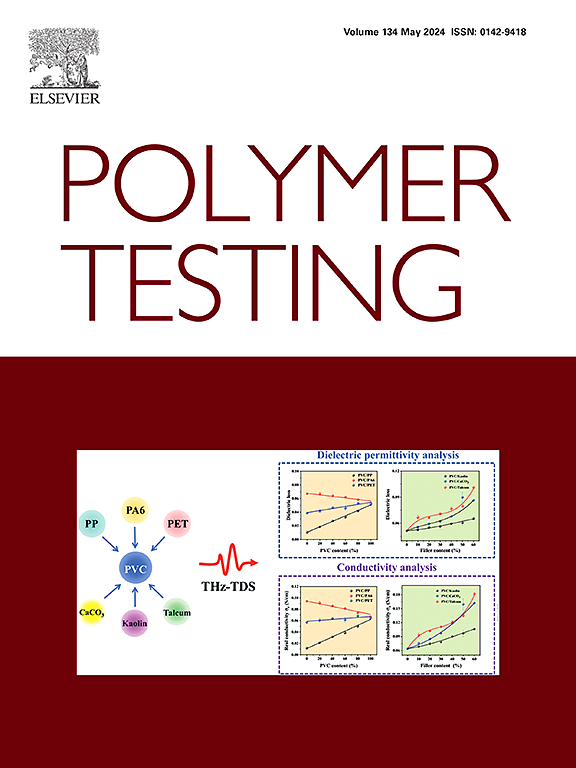Significant enhancement of elasticity of PTT fiber via introduction of helical carbon nanotubes as nano ‘spring'
IF 5
2区 材料科学
Q1 MATERIALS SCIENCE, CHARACTERIZATION & TESTING
引用次数: 0
Abstract
Due to its excellent physical properties and outstanding resilience, poly (trimethylene terephthalate) (PTT) fiber is widely used for daily clothing, work clothing, sportswear, and casual wear. However, in some special cases where both large elongation and quick recovery are required, PTT fiber still faces challenges. In this paper, one facile and novel approach to improve the elasticity of PTT fiber through introducing helical carbon nanotubes (HCNTs) as nano ‘spring’. PTT fiber containing modified HCNTs (PTTHf) was successfully prepared through melt spinning and heat drawing. After 100 cycles of stretching testing, the elastic recovery ratio of PTTHf was still high up to 96 % at fixed elongation of 10 %, which was 22 % higher than that of control PTT fiber (PTTf). More interestingly, the complete recovery time of PTTHf-1.0 at fixed elongation of 20 % was only 5 min, while that of PTTf soared to more than 30 min. The instantaneous recovery speed of PTTHf-1.0 was extraordinarily as high as 50 %/ms, while that of PTTf was only 1.8 %/ms, reflecting the effect of the ‘spring’ characteristics of HCNTs.

螺旋碳纳米管作为纳米“弹簧”对PTT纤维弹性的显著增强
聚对苯二甲酸三甲酯(PTT)纤维由于其优异的物理性能和优异的回弹性,被广泛用于日常服装、工作服、运动服、休闲服等。然而,在一些特殊情况下,需要大伸长率和快速恢复,PTT纤维仍然面临挑战。本文通过引入螺旋碳纳米管(HCNTs)作为纳米“弹簧”,提出了一种提高PTT纤维弹性的简单新颖的方法。采用熔融纺丝和热拉伸法制备了含改性HCNTs (PTTHf)的PTT纤维。经过100次循环拉伸试验,在固定伸长率为10%时,PTTHf的弹性回复率仍然很高,达到96%,比对照PTT纤维(PTTf)提高了22%。更有趣的是,在固定伸长率为20%时,PTTHf-1.0的完全恢复时间仅为5 min,而PTTf的完全恢复时间则飙升至30 min以上。PTTHf-1.0的瞬时恢复速度高达50% /ms,而PTTf的瞬时恢复速度仅为1.8% /ms,这反映了HCNTs的“弹簧”特性的作用。
本文章由计算机程序翻译,如有差异,请以英文原文为准。
求助全文
约1分钟内获得全文
求助全文
来源期刊

Polymer Testing
工程技术-材料科学:表征与测试
CiteScore
10.70
自引率
5.90%
发文量
328
审稿时长
44 days
期刊介绍:
Polymer Testing focuses on the testing, analysis and characterization of polymer materials, including both synthetic and natural or biobased polymers. Novel testing methods and the testing of novel polymeric materials in bulk, solution and dispersion is covered. In addition, we welcome the submission of the testing of polymeric materials for a wide range of applications and industrial products as well as nanoscale characterization.
The scope includes but is not limited to the following main topics:
Novel testing methods and Chemical analysis
• mechanical, thermal, electrical, chemical, imaging, spectroscopy, scattering and rheology
Physical properties and behaviour of novel polymer systems
• nanoscale properties, morphology, transport properties
Degradation and recycling of polymeric materials when combined with novel testing or characterization methods
• degradation, biodegradation, ageing and fire retardancy
Modelling and Simulation work will be only considered when it is linked to new or previously published experimental results.
 求助内容:
求助内容: 应助结果提醒方式:
应助结果提醒方式:


